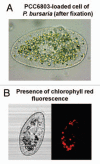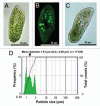Forced symbiosis between Synechocystis spp. PCC 6803 and apo-symbiotic Paramecium bursaria as an experimental model for evolutionary emergence of primitive photosynthetic eukaryotes
- PMID: 21494093
- PMCID: PMC3218470
- DOI: 10.4161/psb.6.6.15239
Forced symbiosis between Synechocystis spp. PCC 6803 and apo-symbiotic Paramecium bursaria as an experimental model for evolutionary emergence of primitive photosynthetic eukaryotes
Abstract
Single-cell green paramecia (Paramecium bursaria) is a swimming vehicle that carries several hundred cells of endo-symbiotic green algae. Here, a novel model for endo-symbiosis, prepared by introducing and maintaining the cells of cyanobacterium (Synechocystis spp. PCC 6803) in the apo-symbiotic cells of P. bursaria is described.
Figures




References
-
- Aonuma M, Kadono T, Kawano T. Inhibition of anodic galvanotaxis of green paramecia by T-type calcium channel inhibitors. Z Naturforsch. 2007;62:93–102. - PubMed
-
- Furukawa S, Karaki C, Kawano T. Micro-particle transporting system using galvanotactically stimulated apo-symbiotic cells of Paramecium bursaria. Z Naturforsch. 2009;64:421–433. - PubMed
-
- Irie K, Furukawa S, Kadono T, Kawano T. A green paramecium strain with abnormal growth of symbiotic algae. Z Naturforsch. 2010;65:681–687. - PubMed
-
- Brown JA, Nielsen PJ. Transfer of photosynthetically produced carbohydrates from endosymbiotic Chlorellae to Paramecium bursaria. J Protozool. 1974;21:569–570. - PubMed
-
- Tanaka M, Miwa I. Significance of photosynthetic products of symbiotic Chlorella to establish the endosymbiosis and to express the mating reactivity rhythm in Paramecium bursaria. Zool Sci. 1996;13:685–692.
MeSH terms
Substances
LinkOut - more resources
Full Text Sources
Miscellaneous
